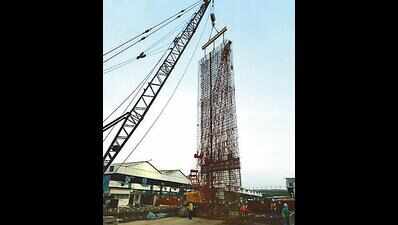- News
- City News
- delhi News
- Launch pad: Tunnelling work kicks off for Delhi leg of RRTS corridor at Anand Vihar
Trending
This story is from June 14, 2021
Launch pad: Tunnelling work kicks off for Delhi leg of RRTS corridor at Anand Vihar

New Delhi: After constructing the first pillar (pier) of the 82-km Delhi-Meerut Regional Rapid Transit System (RRTS) corridor’s Delhi section last week, the project marked another milestone on Sunday with tunnelling work for the underground section starting at Anand Vihar.
When operational, the 3-km tunnel connecting Anand Vihar and Sarai Kale Khan RRTS stations would be the longest for any metro system in the country.
On Sunday, the construction of the “launching shaft” for tunnelling work commenced at Anand Vihar, where one of the three RRTS stations in Delhi would come up, a spokesperson of the National Capital Region Transport Corporation said.
The official added that the first Diaphragm Wall (D-Wall) panel reinforcement cage, which has a height of a 10-storey building at 20-metre deep, apart from the 5-metre width, was lowered and concreted on Sunday. “The D-wall acts as a shield or frame to balance the earth pressure, thereby reducing the possibility of soil collapse and also prevents water seepage during excavation,” the spokesperson said.
An air ventilation shaft, the spokesperson said, will be constructed in between this large section connecting both sides of the tunnel to ensure the safety of passengers during any emergency. “Emergency evacuation facility for passengers is also being constructed to facilitate safe exit from tunnels, in a rare eventuality requiring evacuation,” he said.
These tunnels will be of higher diameter as compared to that of metro systems in the country due to the larger RRTS trains with higher design speed of 180 kmph. “The internal clear diameter of these tunnels is 6.5 metre to reduce air pressure and discomfort to passengers, due to generation of shock waves in tunnels because of the higher speed of these trains,” the spokesman added.
When operational, the 3-km tunnel connecting Anand Vihar and Sarai Kale Khan RRTS stations would be the longest for any metro system in the country.
On Sunday, the construction of the “launching shaft” for tunnelling work commenced at Anand Vihar, where one of the three RRTS stations in Delhi would come up, a spokesperson of the National Capital Region Transport Corporation said.
The official added that the first Diaphragm Wall (D-Wall) panel reinforcement cage, which has a height of a 10-storey building at 20-metre deep, apart from the 5-metre width, was lowered and concreted on Sunday. “The D-wall acts as a shield or frame to balance the earth pressure, thereby reducing the possibility of soil collapse and also prevents water seepage during excavation,” the spokesperson said.
The launching shaft is located at the south side of the upcoming underground Anand Vihar RRTS station. “Two tunnel boring machines (TBMs) will be lowered in the shaft to bore twin tunnels from Anand Vihar towards Sarai Kale Khan,” he said, adding that the total drive of these two TBM machines will be around 3kms in length.
An air ventilation shaft, the spokesperson said, will be constructed in between this large section connecting both sides of the tunnel to ensure the safety of passengers during any emergency. “Emergency evacuation facility for passengers is also being constructed to facilitate safe exit from tunnels, in a rare eventuality requiring evacuation,” he said.
These tunnels will be of higher diameter as compared to that of metro systems in the country due to the larger RRTS trains with higher design speed of 180 kmph. “The internal clear diameter of these tunnels is 6.5 metre to reduce air pressure and discomfort to passengers, due to generation of shock waves in tunnels because of the higher speed of these trains,” the spokesman added.
End of Article
FOLLOW US ON SOCIAL MEDIA










